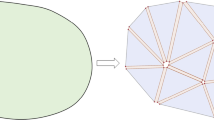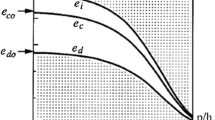Abstract
The study of drying process in soils has received an increased attention in the last few years. This is very complex phenomenon that generally leads to the formation and propagation of desiccation cracks in the soil mass. In recent engineering applications, high aspect ratio elements have proved to be well suited to tackle this type of problem using finite elements. However, the modeling of interfaces between materials with orthotropic properties that generally exist in this type of problem using standard (isotropic) constitutive model is very complex and challenging in terms of the mesh generation, leading to very fine meshes that are intensive CPU demanding. A novel orthotropic interface mechanical model based on damage mechanics and capable of dealing with interfaces between materials in which the strength depends on the direction of analysis is proposed in this paper. The complete mathematical formulation is presented together with the algorithm suggested for its numerical implementation. Some simple yet challenging synthetic benchmarks are analyzed to explore the model capabilities. Laboratory tests using different textures at the contact surface between materials were conducted to evaluate the strengths of the interface in different directions. These experiments were then used to validate the proposed model. Finally, the approach is applied to simulate an actual desiccation test involving an orthotropic contact surface. In all the application cases the performance of the model was very satisfactory.












(© 2009 Canadian Science Publishing or its licensors. Reproduced with permission)




Similar content being viewed by others
References
Abu Al-Rub RK (2007) Prediction of micro and nanoindentation size effect from conical or pyramidal indentation. Mech Mater 39:787–802. https://doi.org/10.1016/j.mechmat.2007.02.001
Amarasiri AL, Kodikara JK, Costa S (2011) Numerical modelling of desiccation cracking. Int J Numer Anal Methods Geomech 35:82–96. https://doi.org/10.1002/nag.894
Asahina D, Houseworth JE, Birkholzer JT et al (2014) Hydro-mechanical model for wetting/drying and fracture development in geomaterials. Comput Geosci 65:13–23. https://doi.org/10.1016/j.cageo.2013.12.009
ASTM D3080 (2011) American Society for Testing and Materials. Stand Test Method Direct Shear Test Soils Under Consol Drained Cond. https://doi.org/10.1520/E0606-04E01
Caballero A, Carol I, López CM (2006) A meso-level approach to the 3D numerical analysis of cracking and fracture of concrete materials. Fract Eng Mater Struct 29:979–991
Caggiano A, Etse G, Martinelli E (2012) Zero-thickness interface model formulation for failure behavior of fiber-reinforced cementitious composites. Comput Struct 98–99:23–32. https://doi.org/10.1016/j.compstruc.2012.01.013
Carol I, Prat PC, López CM (1997) Normal/shear cracking model: application to discrete crack analysis. J Eng Mech 123:765–773. https://doi.org/10.1061/(ASCE)0733-9399(1997)123:8(765)
Chen Q, Andrade JE, Samaniego E (2011) AES for multiscale localization modeling in granular media. Comput Methods Appl Mech Eng 200:2473–2482. https://doi.org/10.1016/j.cma.2011.04.022
Etse G, Caggiano A, Vrech S (2012) Multiscale failure analysis of fiber reinforced concrete based on a discrete crack model. Int J Fract 178:131–146. https://doi.org/10.1007/s10704-012-9733-z
Ferrara A, Pandolfi A (2008) Numerical modelling of fracture in human arteries. Comput Methods Biomech Biomed Eng 11:553–567. https://doi.org/10.1080/10255840701771743
Geißler G, Netzker C, Kaliske M (2010) Discrete crack path prediction by an adaptive cohesive crack model. Eng Fract Mech 77:3541–3557. https://doi.org/10.1016/j.engfracmech.2010.04.029
Gens A, Carol I, Alonso EE (1989) An interface element formulation for the analysis of soil–reinforcement interaction. Comput Geotech 7:133–151. https://doi.org/10.1016/0266-352X(89)90011-6
Hamid TB, Miller GA (2009) Shear strength of unsaturated soil interfaces. Can Geotech J 46:595–606. https://doi.org/10.1139/T09-002
Hauseux P, Roubin E, Seyedi DM, Colliat JB (2016) FE modelling with strong discontinuities for 3D tensile and shear fractures: application to underground excavation. Comput Methods Appl Mech Eng 309:269–287. https://doi.org/10.1016/j.cma.2016.05.014
Khoei AR, Moslemi H, Majd Ardakany K et al (2009) Modeling of cohesive crack growth using an adaptive mesh refinement via the modified-SPR technique. Int J Fract 159:21–41. https://doi.org/10.1007/s10704-009-9380-1
Lakshmikantha MR, Prat PC, Ledesma A (2009) Image analysis for the quantification of a developing crack network on a drying soil. Geotech Test J. https://doi.org/10.1520/GTJ102216
Li B, Jiang Y, Mizokami T et al (2014) Anisotropic shear behavior of closely jointed rock masses. Int J Rock Mech Min Sci 71:258–271. https://doi.org/10.1016/j.ijrmms.2014.07.013
Liu C, Tang CS, Shi B, Bin Suo W (2013) Automatic quantification of crack patterns by image processing. Comput Geosci 57:77–80. https://doi.org/10.1016/j.cageo.2013.04.008
López CM, Carol I, Aguado A (2008) Meso-structural study of concrete fracture using interface elements. I: numerical model and tensile behavior. Mater Struct 41:583–599. https://doi.org/10.1617/s11527-007-9314-1
López CM, Carol I, Aguado A (2008) Meso-structural study of concrete fracture using interface elements. II: compression, biaxial Brazilian test. Mater Struct 41:601–620
Manzoli OL, Gamino AL, Rodrigues EA, Claro GKS (2012) Modeling of interfaces in two-dimensional problems using solid finite elements with high aspect ratio. Comput Struct 94–95:70–82. https://doi.org/10.1016/j.compstruc.2011.12.001
Manzoli OL, Maedo MA, Bitencourt LAG, Rodrigues EA (2016) On the use of finite elements with a high aspect ratio for modeling cracks in quasi-brittle materials. Eng Fract Mech. https://doi.org/10.1016/j.engfracmech.2015.12.026
Manzoli OL, Maedo MA, Rodrigues EA, Bittencourt TN (2014) Modeling of multiple cracks in reinforced concrete members using solid finite elements with high aspect ratio. In: Bicaninc N, Mang H, Meschke G, de Borst R (eds) Computational modelling of concrete structures (EURO-C 2014, St. Anton am Arlberg, Austria). CRC Press, Balkema
Miller GA, Hamid TB (2007) Direct shear apparatus for unsaturated soil interface testing. ASTM Geotech Test J 30:182–191
Misra A (1999) Micromechanical model for anisotropic rock joints. J Geophys Res 104:23–175. https://doi.org/10.1029/1999JB900210
Molinari JF, Gazonas G, Raghupathy R et al (2007) The cohesive element approach to dynamic fragmentation: the question of energy convergence. Int J Numer Methods Eng 69:484–503. https://doi.org/10.1002/nme.1777
Mota A, Knap J, Ortiz M (2008) Fracture and fragmentation of simplicial finite element meshes using graphs. Int J Numer Methods Eng 73:1547–1570. https://doi.org/10.1002/nme.2135
Nahlawi H, Kodikara JK (2006) Laboratory experiments on desiccation cracking of thin soil layers. Geotech Geol Eng 24:1641–1664. https://doi.org/10.1007/s10706-005-4894-4
Oliver J, Cervera M, Manzoli O (1999) Strong discontinuities and continuum plasticity models: the strong discontinuity approach. Int J Plast 15:319–351. https://doi.org/10.1016/S0749-6419(98)00073-4
Oliver J, Huespe AE, Blanco S, Linero DL (2006) Stability and robustness issues in numerical modeling of material failure with the strong discontinuity approach. Comput Methods Appl Mech Eng 195:7093–7114. https://doi.org/10.1016/j.cma.2005.04.018
Pan PZ, Rutqvist J, Feng XT, Yan F (2014) TOUGH-RDCA modeling of multiple fracture interactions in caprock during CO2 injection into a deep brine aquifer. Comput Geosci 65:24–36. https://doi.org/10.1016/j.cageo.2013.09.005
Pandolfi A, Ortiz M (2002) An efficient adaptive procedure for three-dimensional fragmentation simulations. Eng Comput 18:148–159. https://doi.org/10.1007/s003660200013
Pandolfi A, Weinberg K (2011) A numerical approach to the analysis of failure modes in anisotropic plates. Eng Fract Mech 78:2052–2069. https://doi.org/10.1016/j.engfracmech.2011.03.021
Peron H, Hueckel T, Laloui L, Hu LB (2009) Fundamentals of desiccation cracking of fine-grained soils: experimental characterisation and mechanisms identification. Can Geotech J 46:1177–1201. https://doi.org/10.1139/T09-054
Phongthanapanich S, Dechaumphai P (2004) Adaptive Delaunay triangulation with object-oriented programming for crack propagation analysis. Finite Elem Anal Des 40:1753–1771. https://doi.org/10.1016/j.finel.2004.01.002
Regueiro RA, Borja RI (1999) A finite element model of localized deformation in frictional materials taking a strong discontinuity approach. Finite Elem Anal Des 33:283–315. https://doi.org/10.1016/S0168-874X(99)00050-5
Rodrigues EA, Manzoli OL, Bitencourt LAG Jr et al (2017) An adaptive concurrent multiscale model for concrete based on coupling finite elements. Comput Methods Appl Mech Eng. https://doi.org/10.1016/j.cma.2017.08.048
Rodríguez R, Sánchez M, Ledesma A, Lloret A (2007) Experimental and numerical analysis of desiccation of a mining waste. Can Geotech J 44:644–658. https://doi.org/10.1139/t07-016
Sanchez M, Atique A, Kim S et al (2013) Exploring desiccation cracks in soils using a 2D profile laser device. Acta Geotech 8:583–596. https://doi.org/10.1007/s11440-013-0272-1
Sánchez M, Manzoli OL, Guimarães LJN (2014) Modeling 3-D desiccation soil crack networks using a mesh fragmentation technique. Comput Geotech 62:27–39. https://doi.org/10.1016/j.compgeo.2014.06.009
Simo JC, Oliver J, Armero F (1993) An analysis of strong discontinuities induced by strain-softening in rate-independent inelastic solids. Comput Mech 12:277–296. https://doi.org/10.1007/BF00372173
Wen L, Tian R (2016) Improved XFEM: accurate and robust dynamic crack growth simulation. Comput Methods Appl Mech Eng 308:256–285. https://doi.org/10.1016/j.cma.2016.05.013
Xu XP, Needleman A (1994) Numerical simulations of fast crack growth in brittle solids. J Mech Phys Solids 42:1397–1434. https://doi.org/10.1016/0022-5096(94)90003-5
Zielinski M, Sánchez M, Romero E, Atique A (2014) Precise observation of soil surface curling. Geoderma 226–227:85–93. https://doi.org/10.1016/j.geoderma.2014.02.005
Acknowledgements
Marcelo Sánchez would like to acknowledge the financial support from the Sao Paulo Research Foundation (FAPESP, proc. 2016/19479-2). The authors also acknowledge the support from the National Council for Scientific and Technological Development (CNPq, proc. 234003/2014-6).
Author information
Authors and Affiliations
Corresponding author
Rights and permissions
About this article
Cite this article
Manzoli, O., Sánchez, M., Maedo, M. et al. An orthotropic interface damage model for simulating drying processes in soils. Acta Geotech. 13, 1171–1186 (2018). https://doi.org/10.1007/s11440-017-0608-3
Received:
Accepted:
Published:
Issue Date:
DOI: https://doi.org/10.1007/s11440-017-0608-3




